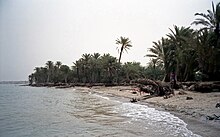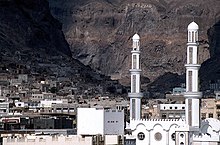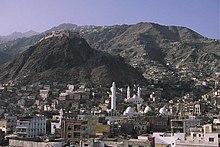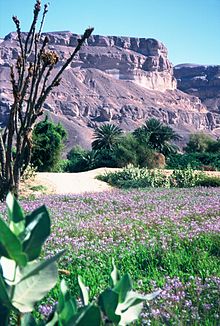Geography of yemen
Yemen can be geographically divided into clearly distinguishable regions. The very different landscape areas vary in terms of ecological potential and requirements for economic development, but, unlike other high cultures such as Mesopotamia or Egypt , they have in common that they do not have permanently flowing waters, rather they are dependent on seasonal rainfall. From this arose the famous irrigation technology for agriculture, which has been cultivated since the 4th century at the latest.
geography
Natural spaces
From west to east, Yemen can be divided into three natural areas as follows: The flat Tihama borders the Red Sea and the southern coastal areas of the former South Yemen . The Tihama is dominated by sand and gravel areas. The coastal plain, between 30 km and 60 km wide, rises increasingly gently and is more structured in the south-west than in the north-west by protruding mountain flanks. Partly there are remains of earlier volcanism; Aden , for example , the former capital of the People's Democratic Republic of Yemen (South Yemen), lies in a double crater . Precipitation is low and very uncertain, so that the agricultural potential of this region is negligible. In recent years, the cultivation of the fields has been supported by means of groundwater pumps. The cultivation of sorghum varieties , maize and cotton has been documented in the artificially irrigated agricultural areas since the 13th century .
Towards the interior of the country, the rugged peripheral mountains rise steeply, in the west several times over 3000 m high. It is a watershed mountain range. From northern Sa'da to southern Taizz , the infrastructure of the long-distance roads is almost never below 1500 meters. Plateaus and basins are interrupted by rugged valley cuts. Clouds from the Red Sea fall in the mountains, with rainfall decreasing from north to south. The extensive terraced cultivation is impressive in southern and central Central Yemen . The Jabal an-Nabi Shuʿaib rises southwest of the capital Sanaa , at 3665 m the highest mountain in the entire Arabian Peninsula . Heavy spring and summer rains enable rain-fed agriculture .
A striking landscape adjoins the mountains, the highlands with wide plateaus and basins. The average heights are between 1800 and 2500 m. The plateau is criss-crossed by wadis . The most famous wadi is the Wadi Hadramaut , which runs parallel to the south coast . This is a mighty limestone block that is furrowed by erosion channels. Large parts are filled with sand and rubble. The water table rises to the east. To the northeast, the highlands descend in steps to the central Arabian sand desert ar-Rubʿ al-kali ( Empty Quarter ). Precipitation is often absent here for years. Agriculture is only possible in isolated river valleys and this is usually supported by groundwater irrigation (e.g. Ma'rib ). In principle, this desert is a depression filled with limestone grains that separates the central Arab highlands from the southern Arabian border threshold. In the direction of historical Shabwa there are mined and minable salt deposits.
geology
Yemen is part of the Arabian Plate , which - separated by the Red Sea - is moving further and further away from the African Plate . The Horn of Africa ( Somalia ) once fitted seamlessly with the Yemeni south-west. The rift valley of the Red Sea continues over Djibouti as the East African Rift ( Great Rift Valley ). The area of Yemen, located directly at the break point of the plates, is still tectonically active today . Earthquakes, hot water and water vapor sources testify to this. Fossilized corals and shells can be found throughout the high altitudes of the country and represent multiple ups and downs of land masses.
However, there are no active volcanoes in Yemen, only a large number of extinct ones. Particularly pronounced volcanic areas dominate the landscape around Dhamar , Sanaa, Mukalla and Aden. Pillow lava , volcanic conveyor channels and deposits shape the picture in some places.
surface
Yemen has a total area of 536,869 km², on which about 19.2 million people live (as of 2008). Yemen is almost exactly 1.5 times the size of Germany , with a population of a quarter.
Highest mountains
- Jabal an-Nabi Shuʿaib , 3665 m
- Jebel Nuqum , 2889 m
- Jabal Mazar , 2760 m
Coordinates
The geographic location of Yemen:
- 43 - 53 ° east longitude
- 13-19 ° north latitude
Political geography
Neighboring States and Natural Borders
Yemen's border countries:
- Oman
- Saudi Arabia with 1,458 km
- Yemen coastline: 1,906 km
- Gulf of Aden in the south
- Arabian Sea in the south
- Red Sea in the west
Governments / capitals
Yemen is divided into 20 governorates and one capital district (updated 2008):
- Abyan / Capital: Zindschibar
- Adan / Aden
- ʿAmrān / ʿAmrān
- al-Baida ' / al-Baida'
- ad-Dali ' / ad-Dali'
- Dhamar / Dhamar
- al-Jauf / al-Hazm
- Hadramaut / al-Mukalla
- Hajjah / Hajjah
- al-Hudaida / al-Hudaida
- Ibb / Ibb
- Lahidsch / Lahidsch
- al-Mahra / al-Ghaida
- al-Mahwit / al-Mahwit
- Ma'rib / Ma'rib
- Raima / Raima
- Sa'da / Sa'da
- Sanaa / Sanaa
- Sanaa (Capital District)
- Shabwa / ʿAtaq
- Ta'izz / Taizz
resources
Natural resources
Gold, silver, copper, iron, lead and zinc have been extracted from mines in some cases since the Sabaean and Himyar times. Alabaster as window glass has been quarried in the country since the Islamic period. Today salt (Salief, Timna) and oil deposits (Shabwat, Mar'ib) play a role.
Land use
Land use of Yemen:
- Forest 5.9%
- Agriculture 2.8%
- Pasture 30.4%
- Others 60.9% (1994)
Individual evidence
- ^ Günther Berger, Relazioni: internationales Wien
- ↑ a b c Simper, Brixel, p. 72 f.
- ↑ a b c Dostal, pp. 331–333
- ↑ Fischer World Almanac 2008
literature
- Gerd Simper, Petra Brixel, Yemen, travel guide, travel know-how , 1992, Därr travel book publishing company, ISBN 3-921497-09-4 .
- Walter Dostal : Traditional economy and society in Werner Daum Yemen , Umschau-Verlag, Frankfurt / Main, ISBN 3-7016-2251-5 .
- Walter Dostal: In search of the future in Werner Daum Yemen , Umschau-Verlag, Frankfurt / Main, ISBN 3-7016-2251-5 .







